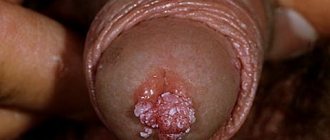Papilloma viruses are the only group of viruses today for which scientists have proven the induction of cancer tumors. Moreover, HPV is the most common sexually transmitted infection; more than half of adults are infected with it. Find out how the papilloma virus manifests itself and how to treat it.
Appointment with a gynecologist - 1000 rubles. Appointment with a urologist - 1000 rubles. Removal of tumors - from 500 rubles. Consultation with a doctor based on the results of ultrasound and tests - only 500 rubles. (at the request of the patient).
MAKE AN APPOINTMENT, TEST OR ULTRASOUND
What is papillomavirus, papillomas, condylomas
The content of the article
Human papillomavirus infection (HPV) belongs to the genus A of the Papovaviridae family and is transmitted primarily through sexual contact, infecting epithelial (cover) cells - the skin, mucous membrane and urogenital area. Infection of the skin and genital organs occurs through microtraumas. The papilloma virus is contained in the urethra, Bartholin's glands and seminal fluid. The development of malignant tumors of the penis, vagina, and cervix is associated with human papillomavirus.
HPV strains, of which science knows more than 100, behave differently in the cell. Some exist separately from chromosomes, others are able to integrate into the cell genome (they most often cause complications). When the viral DNA is inserted into the nucleus of the host cell, it controls the cell's genetic material, leading the cell to malignant transformation. During the replication cycle, the human papillomavirus genome expresses 8–10 protein products. Oncogenicity is determined by proteins E6 and E7. It is difficult to kill the infection - the virus remains viable at a temperature of 50 degrees. From 30 minutes.
The virus infects stem cells located in the basal layer, and they transmit the infection to the surface epithelial cells. Superficial dividing immature cells are especially susceptible to HPV, which explains the high risk of oncogenes affecting the vulva, lower part of the vagina and cervix.
The most common visual manifestation of papillomavirus is papillomas. The formation got its name from the Latin papilla - nipple + Greek oma - tumor. Papillomas can develop into cancer. The development of oncology can be prevented by monitoring the development of papillomas and removing them in a timely manner.
A type of papillomavirus in women and men is genital and flat condylomas that develop on the genitals. They must also be removed.
A complication of the virus is a precancerous condition - cervical dysplasia and its logical conclusion - cervical cancer. You can avoid cancer by treating dysplasia. Treatment also involves removing the affected layer of cells.
What do condylomas look like?
The formation of growths in the intimate area is a common reason for girls to make an appointment with a gynecologist. Papillomas on the labia are small white growths. Vaginal papillomas can be of 2 types: exophytic and endophytic. The former are characterized by a papillary surface and a pointed shape; they are localized in the superficial layer. As a rule, they are provoked by HPV with a fairly low level of oncogenic activity. The latter are flat, they usually grow deep into the epithelial tissue and can cause pathologies in healthy tissue.
If such condylomas are not treated in time, the risk of developing cancer increases.
How papillomavirus is transmitted, risks
Papillomavirus enters the human body in different ways, the probability of infection is 60%. You can get an infection in the following ways:
- Sexually, regardless of the type of sexual relations - oral, genital and anal. The presence of genital warts in a partner guarantees infection by 98-100%.
- Contact household - in the case of using a shared towel, washcloths, etc. The virus can also be transmitted through saliva during a kiss.
- Through wounds - a violation of the integrity of the skin and mucous membranes - an open gateway to the body.
- Infection of a child during the passage of the birth canal - children suffer from rare forms, papillomas grow in the nasopharynx and sinuses. Recent studies have shown that children born by cesarean section also become infected - this may indicate that the virus is able to penetrate the placenta.
Infection does not always guarantee the development of the disease. HPV causes disease in the body in 50% of cases, the rest are limited to carriage of the infection: a strong immune system can keep the virus in numbers that are not dangerous to the body. The incubation period ranges from a year to 20 years, with an average of 3-5 years.
The development of the disease is provoked by hormonal imbalances, immunodeficiency states, and sexually transmitted infections (STDs, STIs). Any condition that reduces immunity increases the risk - pregnancy, bad habits, chronic diseases, stress, etc.
It should be understood that infection of epithelial cells is a necessary but not sufficient factor for the development of oncology. According to Professor V.A. Molochkov, a well-known and respected scientist in the world of medicine, a number of other factors are necessary for the development of irreversible neoplasia:
- active expression of genes E6, E7 of highly oncogenic types hpv16 and hpv18;
- induction of estradiol metabolism to 16-OH;
- multiple damage to chromosomal DNA in an infected cell.
The first stage of CIN I neoplasia is expressed by active copying of the virus and its asymptomatic course. Tumor development is stimulated by the interaction of papillomavirus with cytomegaloviruses, trachomatis, mycoplasmas, ureaplasmas, and herpes simplex virus type 2.
Routes of infection
Infection is possible not only through sexual intercourse, although this is the most common cause. HPV infection is also possible through household means:
- when using common hygiene and tableware;
- through contact with an infected person in the acute stage in the presence of microtraumas;
- the possibility of HPV transmission through household items is still being debated.
The transplacental route of infection is rare - from mother to child, even at the stage of intrauterine development of the fetus.
Important numbers: the statistics are scary
- In the last 10 years, the number of people infected with hpv
has increased 12-fold. - HPV ranks second after genital herpes among all female infections and is found in 70% of adult women.
- Papillomavirus is the cause of all cases of cervical cancer.
- HPV is associated with 50% of anogenital cancers.
- The greatest risk of infection is between the ages of 18 and 25. The peak age for development of cervical dysplasia is 30 years, and cervical cancer is 45 years.
Types of HPV
Scientists know more than 100 types of papillomaviruses. A third of them infect the human urogenital tract, affecting the skin and mucous membranes of the genital organs. A fifth of the viruses in this group have not yet been studied and may well present new unpleasant surprises.
The papilloma virus is classified according to its oncogenicity and area of damage:
- Non-genital - nasopharynx, mouth, sinuses, vocal cords, lungs;
- Affects the organs of the urinary system - ureters and bladder, urethra, renal pelvis;
- Genital in women - affects the mucous membranes of the external genitalia, the vestibule of the vagina and the vagina itself, the perianal area, the cervix, the perineum;
- Genital in men - affects the glans penis, foreskin, frenulum, coronary sulcus, shaft of the penis, scrotum, groin skin, pubis, perineum, perianal area. The external opening of the urethra in men is affected in 20-24% of cases.
Based on oncogenicity, HPV can be divided into:
- HPV low risk - type 6,11,42,43,44;
- HPV average risk 31,33,35,51,52,58;
- HPV high risk 16,18, 45, 56.
The most dangerous types of HPV papillomavirus (hpv) - those belonging to the high cancer risk group - are 16, 18, 31, 33, 35, 39, 45, 51, 52. They cause genital cancer.
How dangerous the papillomavirus is for men and women can be understood by looking at the table of diseases associated with HPV activity.
Classification of the disease
- Bladder papilloma;
About 70% of all papillomas are localized in various parts of the bladder. Most often in the area of the triangle, then in the neck, dome of the bladder and lateral wall.
- Ureteral papilloma;
Can simulate ureteral colic with significant obstruction of the ureteral lumen.
- Renal pelvic papilloma;
Most often it is an accidental finding, as it develops asymptomatically for a long time.
- Urethral papilloma;
It is located in the urethra, so it is usually detected earlier than in other locations.
Diseases caused by HPV (table)
| Disease, clinical manifestation | Type hpv |
| Skin diseases | |
| Plantar warts | 1,2,4 |
| Common (simple) warts | 2, 4, 26, 27, 29, 57 |
| Butcher's warts | 7 |
| Flat warts | 3, 10, 28, 49 |
| Verruciform epidermodysplasia (hereditary disease - verrucous dysplasia) | 2, 3, 5, 8, 9, 10, 12, 14, 15, 17, 19, 20, 36, 37, 46, 47, 50 |
| Diseases of the genital mucosa | |
| Flat condylomas, cervical dysplasia | 6, 11, 16, 18, 30, 31, 33, 39, 40, 42, 43, 51, 52, 55, 57, 61, 62, 64, 67 |
| Condylomas acuminata | 6, 11, 42, 54 |
| Cervical cancer, genital cancer, vaginal cancer, anal cancer | 16, 18, 31, 33, 35, 39, 45, 51, 52, 54, 56, 66, 68 |
| Diseases of the mucous membranes | |
| Epithelial hyperplasia of the oral mucosa | 13, 32 |
| Neck, lung and head cancer | 2, 6, 11, 16, 18, 30 |
| Respiratory tract papillomatosis | 6, 11, 30 |
One patient can be infected with several types of papillomavirus at the same time, which is usually the case.
Symptoms of papillomavirus
HPV infection can be asymptomatic or give the following symptoms:
Genital warts (genital warts)
Fibroepithelial (skin) neoplasms with a thin stalk or a broad base. They can be single or merge, forming a growth that looks like a cauliflower head. Condylomas can become inflamed and bleed when injured, as they contain blood vessels that feed them.
Condylomas can be found on the clitoris, labia minora, urethra, vagina, cervix, around the anus and in the anus. Exophytic forms of OC are a consequence of the activity of benign types of the HPV virus - 6, 11. Endophytic condylomas (flat and inverted) grow on the cervix and initially do not give symptoms. Detected during extended colposcopy. Genital warts affecting the lips, tongue and palate are visible during routine examination.
People with HIV and during pregnancy develop very large genital warts. Giant Buschke-Levenshtein condyloma is not uncommon.
- Anal warts.
Anal warts can be found up to the dentate line of the rectum. At first they do not cause discomfort, but over time they itch, hurt, and smell unpleasant. - Urethral warts.
In women, the external urethral opening is affected in no more than 8%. Such warts are easily identified by a gynecologist. Deep damage to the urethra (urethra) cannot be determined visually, but the disease gives symptoms of sluggish urethritis. Urethral warts in men cause a split urine stream associated with a narrowing of the urethral opening.
Flat condylomas
Flat condylomas do not protrude above the surface of the mucous membranes, which is why they got their name. These formations have a high oncogenic potential. Most often, flat condylomas are located on the cervix and vaginal mucosa. Flat condylomas can only be detected by colposcopy.
Dysplasia, cervical cancer
Dysplasia is a tissue pathology associated with the modification and degeneration of cells. This is a precancerous condition. There are 3 degrees of the disease, all of which are detected by colposcopy. Stages 2 and 3 require surgical treatment. Cervical dysplasia is preceded by cervical erosion.
Cervical cancer is a consequence of dysplasia. It is the most common tumor of the female reproductive organs. It may be asymptomatic or cause pain, bleeding and other symptoms characteristic of problems with the female reproductive system.
How to get rid of genital papillomas?
Despite the scale of research and understanding of the problem by the medical scientific community, it has not been possible to develop specific drugs for the treatment of HPV, as already mentioned. Some countries offer vaccination against the virus at an early age. However, high positive results cannot be achieved with this measure. After all, the vaccine is effective for a fairly short time, but the risk of infection is present throughout life.
Important: The HPV vaccine can only protect up to a certain point. For example, young people who have not reached puberty and have no history of sexual contact are offered to use this type of protection against the virus. After all, it is during adolescence, when the first sexual experience is acquired, that the greatest change of sexual partners is noted, weakened immunity is diagnosed, and infection most often occurs.
But if you couldn’t protect yourself from the virus, you can fight it. An integrated approach to treatment includes:
- measures to strengthen the immune system, because the body’s internal defenses can suppress the activity of the virus;
- taking antiviral drugs that chemically inhibit the spread of the virus;
- removal of papillomas on the genitals, oral cavity and other parts of the body.
Important: If HPV is detected in one partner in a couple, treatment is carried out on both of them, because the risk that both are infected is more than 80%. An adequate, gentle treatment program is developed for an individual patient or couple, taking into account the manifestations of the disease and the type of virus identified through laboratory tests.
There is a chance of self-healing, but it is quite low. And not in a couple where there will be constant relapses. At the same time, a well-chosen treatment tactic by a doctor allows you to get rid of the pathology quite quickly.
Important: It is strictly not recommended to remove papillomas at home, since the use of aggressive media based on vinegar and iodine is dangerous to health. An extensive tissue burn may form at the site of exposure. In this case, self-medication will not bring the desired result. After all, the skin tumor must be removed completely “at the root.” Only in this case it will not grow again.
Do not try to remove warts at home or in a beauty salon. Such treatment does not provide a complete picture of a person’s health status. The type of virus is not determined, and antiviral therapy is not carried out. This means that the symptoms are only muted, and the problem gets worse.
Medical methods for treating genital and other types of papillomas are:
- Radio wave method.
- Laser method.
- Use of liquid nitrogen.
The best of them today is burning out tumors with a laser. A safe, bloodless and painless method has virtually no contraindications. One or two warts are removed in 5 minutes. Hospitalization of the patient is not required, as the procedure is performed on an outpatient basis. Immediately after micro-surgery, a person can return to his usual lifestyle.
The laser burns out pathological tissue completely and without a trace. There are no scars or scars left on the skin. Papilloma on the genitals or in the perineum is removed forever. It is enough to look at the photos of the skin before and after the procedure to be convinced of this.
You can learn more about laser removal of warts at the Lasersvit clinic at your appointment. You can sign up for a consultation right now at a time convenient for you.
How are papillomas on the genitals in men removed?
Many men are embarrassed by warts on the penis and try to remove them at home using various aggressive media. This is a harmful practice that carries a high risk of complications. A secondary infection may be added to a skin burn. In this case, the treatment will be long. At the same time, it is not difficult to get rid of penile HPV if you go to a specialized medical institution.
Our clinic employs qualified dermatologists who clearly know how to treat papillomavirus on the penis. Rest assured, in a fairly short period of time there will be no trace of the pathology left.
We use a laser method that allows us to target the overgrown tissue of the epidermis. Adjacent tissues are not damaged. And since the capillaries are immediately cauterized, no bleeding occurs.
How are papillomas on the genitals of women removed?
Due to the structural features of the female genital organs, removal of papillomas in women is somewhat more difficult. The papillomavirus on the genitals of women often spreads not only to the external genitalia, but also to the vagina and cervix. Therefore, the removal of warts after a thorough examination, taking tissue samples, in case of external manifestations is carried out by a dermatologist, and in case of internal manifestations, it is carried out by a gynecologist. Any independent attempts to get rid of papillomas are unacceptable and dangerous.
Papilloma virus - diagnosis
Human papillomavirus can be detected in its early stages only by laboratory methods. The infection can be detected visually only when condylomas or papillomas appear. If HPV is suspected, the following are prescribed:
- Gynecological examination
or examination by a urologist with taking smears for an HPV test. If condylomas are detected, urethroscopy is performed. In case of cervical erosion, the gynecologist must take a smear for oncocytology. - If HPV is detected, a colposcopy is required - examination of the vagina and cervix with a gynecological microscope - colposcope. The doctor uses special tests to exclude hidden pathologies.
- Colposcopy with biopsy.
Indicated for all women with neoplasia. At the same time, coloring and exposure to suspicious areas is carried out. A sign of APC may be whitish areas formed after treatment with vinegar, uneven accumulation of iodine when exposed to Lugol's solution, a mosaic pattern, and protrusions of the epithelium. - Histological and cytological examination
- assessment of the cellular composition, and the cells themselves, for atypicality (cancer). - PCR – search for traces of papillomavirus DNA. This is the most accurate and diagnostically informative analysis that detects the papilloma virus in men and women and specifies its type.
To assess the viral load, a quantitative HPV test is recommended, which determines the critical concentration of the virus associated with the risk of malignancy of tumors. The analysis is also carried out to assess the effectiveness of treatment.
Treatment of papillomavirus
Unfortunately, medicine is not yet able to completely rid the body of the virus. Therefore, the task of the doctor and the patient is to deal with the consequences in a timely manner. It is recommended to remove all warts and treat precancer and cancer stages. According to recent studies in the USA, the human immune system is able to cope with HPV on its own within 2 years after infection in 90% of cases. If this does not happen, treatment is strictly necessary. Papillomas are removed using the following methods:
- Surgical removal
is an outdated but effective method. Recommended in exceptional cases. - Electrocoagulation
– cauterization of affected areas with electric current. Not everyone likes the method, as it can also affect healthy tissue. - Laser coagulation
- laser cauterization - is the most modern and effective method that gives a minimum of complications. - Cryodestruction with liquid nitrogen
differs from other methods in that the pathological growth is affected by cold. Requires a lot of experience from the doctor. - Chemical cauterization
- the doctor acts on the diseased area with concentrated acids or alkalis. The method can also affect healthy skin - the chemical will leave a scar. - The radio wave method
is the most expensive, but the best. Does not cause pain, complications, bleeding. Does not leave scars.
You can read more about methods for removing tumors in the “Low-traumatic operations” section.
After removal, antiviral treatment and means to restore and strengthen the immune system are prescribed.
Papillomas on the genitals: causes of pathology development
The most common route of infection is direct contact, in which the skin and mucous membranes of the virus carrier and a healthy person come into contact. As a rule, this is sexual contact. Although there is a risk of infection of the child from the mother, the household method is through personal hygiene items. You can also become infected with HPV in common areas – swimming pools, showers.
Important: With each new sexual partner, the risk of infection for a healthy person increases by 20%. Unfortunately, standard protective equipment used during sexual intercourse does not protect against HPV, since latex products do not protect all parts of the genital organs from contact.
The causes of infection are not as important as methods of combating it. After all, the risk of direct or household infection is very high. The main thing is to start treatment on time to avoid complications. It is noteworthy that Western scientists understand the importance of the problem. Up to 6 billion dollars a year are allocated for HPV research and the development of new treatment protocols in the USA alone. But a medicine that will cure the virus once and for all has not been found. However, today’s methods of combating pathology are quite effective with timely access to a specialized medical institution.
Prevention of papilloma virus
You can prevent the appearance of warts by maintaining personal hygiene. You should not touch other people's papillomas, condylomas, etc. You can protect yourself from genital warts by barrier contraception (using a condom), but if the formations are on external tissues, this will not help. The most effective method of protecting against HPV is strengthening the immune system.
Girls and boys are recommended to get vaccinated against HPV. The vaccine prevents the occurrence of cervical cancer, vulvar cancer, vaginal cancer, genital warts and other diseases associated with papillomavirus. There are three types of vaccines against papillomavirus. In Russia, the drug Gardasil is recommended, directed against 4 types of hpv (16, 18, 6, 11).
The vaccine is given three times, starting at age 9 and before the start of sexual activity. Women can get vaccinated up to 26 years of age, but the drug will not work against viruses that are already in the body.
Why do vaginal papillomas occur?
The main cause of papilloma in the vagina is the papilloma virus. It enters the body through unprotected sexual contact with a carrier. However, there are a number of factors that increase the likelihood of infection. These include sexually transmitted diseases (for example, gonorrhea and chlamydia).
Also, the reasons that contribute to the development of papillomas are:
- frequent change of sexual partners;
- disruption of the normal vaginal microflora (dysbiosis);
- low immunity;
- inflammation of the ovaries;
- severe stressful situations;
- pregnancy;
- deviations from the endocrine system;
- lack of vitamins in the body.
If several of the reasons described above are present, the risk of infection increases significantly. The incubation period is no more than 3 months, but under the influence of unfavorable circumstances for the immune system, this time can be reduced to 14-20 days.
Where is papillomavirus treated in St. Petersburg, prices
You can contact the Diana private clinic in St. Petersburg for diagnosis and treatment of papillomavirus. We use modern methods approved in the best European clinics, and the prices for specialist services are quite affordable.
Here you can get tested for the human papillomavirus and remove any tumors. Removal of formations associated with HPV is carried out using the latest Fotek radioknife with a coagulator that prevents bleeding. Price for removal of condylomas, papillomas, etc. — from 500 rub. We also offer the HPV vaccine with Gardasil.
Why do genital warts recur?
Even if treatment is carried out on time, it does not guarantee against relapse.
The virus can become inactive, but remain in the body.
The reappearance of growths often occurs due to a decrease in protective mechanisms.
Decreased immunity causes the process to spread to intimate places.
When infected with the immunodeficiency virus, genital warts grow faster.
With this disease, giant colonies may appear.
Treatment of patients with HIV requires special experience from the doctor, usually it is surgical.
At the second stage, liquid nitrogen removal technology is used.









